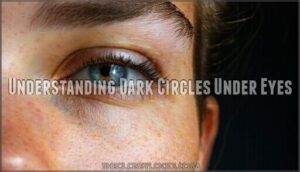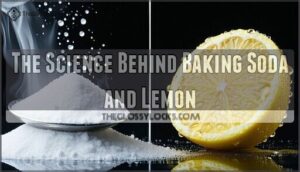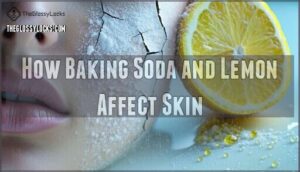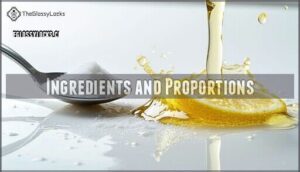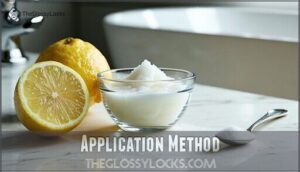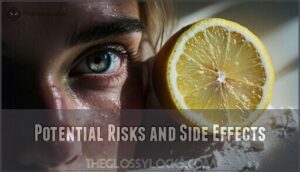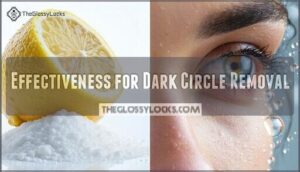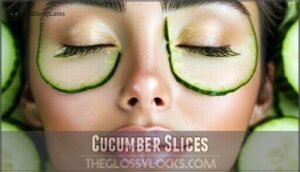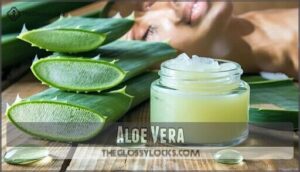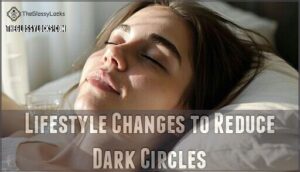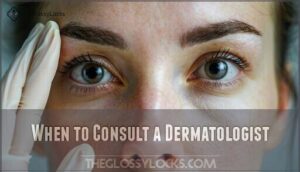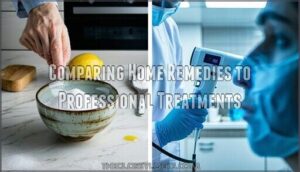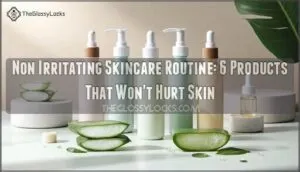This site is supported by our readers. We may earn a commission, at no cost to you, if you purchase through links.
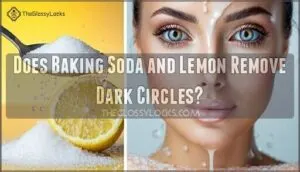 Using baking soda and lemon for dark circles might sound promising, but it’s not backed by science and can harm your skin.
Using baking soda and lemon for dark circles might sound promising, but it’s not backed by science and can harm your skin.
Baking soda’s alkaline nature disrupts your skin’s protective barrier, while lemon’s acidity can cause irritation or even burns, especially on sensitive under-eye skin.
While both ingredients have their own benefits—baking soda for cleaning and lemon for brightening—dark circles are more complex.
They’re usually linked to genetics, sleep, or lifestyle habits, not surface pigmentation alone.
Instead, focus on hydration, rest, and gentle remedies like cucumber slices or tea bags.
Curious about safer, science-backed solutions? Keep exploring natural alternatives!
Table Of Contents
- Key Takeaways
- Does Baking Soda and Lemon Remove Dark Circles?
- Understanding Dark Circles Under Eyes
- The Science Behind Baking Soda and Lemon
- How Baking Soda and Lemon Affect Skin
- DIY Baking Soda and Lemon Mask Recipe
- Potential Risks and Side Effects
- Effectiveness for Dark Circle Removal
- Alternative Natural Remedies for Dark Circles
- Lifestyle Changes to Reduce Dark Circles
- When to Consult a Dermatologist
- Comparing Home Remedies to Professional Treatments
- Frequently Asked Questions (FAQs)
- Does baking soda work on dark circles?
- Does lemon juice help dark circles?
- How do you get rid of dark circles under your eyes?
- How to get rid of dark circles naturally?
- Is baking soda good for under eye circles?
- Can baking soda remove dark circles?
- How long does lemon take to remove dark circles?
- What happens if we apply baking soda and lemon on face?
- Can baking soda remove dark circles under eyes?
- Does lemon get rid of dark circles under eyes?
- Conclusion
Key Takeaways
- Don’t use baking soda and lemon for under-eye dark circles; it can irritate your skin and worsen the problem.
- These ingredients disrupt your skin’s natural pH, causing dryness, sensitivity, and long-term damage.
- Dark circles are often caused by genetics, fatigue, or lifestyle, which DIY remedies like these don’t address.
- Safer alternatives like cucumber slices, tea bags, aloe vera, and professional treatments are better for lasting results.
Does Baking Soda and Lemon Remove Dark Circles?
You’ve probably seen countless DIY tutorials claiming that baking soda and lemon juice can banish dark circles overnight, but here’s the reality check: this popular dark circles remedy lacks scientific backing.
This trendy dark circle hack might sound tempting, but it’s not backed by science and risks more harm than help.
Expert opinions consistently warn about baking soda risks and lemon juice concerns, as both ingredients can irritate delicate under eye circles.
Remedy effectiveness remains questionable, making safe alternatives your better bet.
Understanding Dark Circles Under Eyes
You’ve likely noticed those stubborn dark circles under your eyes and wondered what causes them to appear.
Dark circles develop from various factors including fatigue, genetics, aging, and sun exposure, which make blood vessels more visible or cause pigmentation changes in the delicate under-eye skin.
Causes of Dark Circles
Why do those pesky dark circles appear under your eyes?
Several factors contribute to this common concern. Fatigue Influence tops the list—when you’re exhausted, your skin becomes pale, making blood vessels more visible.
Allergy Impact causes inflammation and broken capillaries from rubbing itchy eyes. Aging Effects thin your skin and reduce collagen, exposing underlying vessels.
Sun Exposure triggers excess melanin production, creating hyperpigmentation. Genetic Factors also play a role in developing under eye circles.
Understanding these causes helps you choose the right dark circles remedy for your specific situation.
Common Misconceptions
You’ve probably heard countless claims about DIY skincare remedies promising immediate results for dark circles.
Many believe baking soda benefits include magical skin lightening, while others swear by lemon juice’s bleaching effect.
The truth? These misconceptions ignore DIY safety concerns and long-term efficacy questions. Baking soda and lemon combinations often cause skin irritation rather than improvement.
Social media fuels these myths, but your delicate under-eye area deserves better than harsh, unproven treatments that can worsen your condition.
A better approach involves a dedicated skin care routine that addresses the underlying causes.
The Science Behind Baking Soda and Lemon
You’ve probably heard that baking soda and lemon can tackle dark circles, but understanding their individual properties helps explain why this combination attracts attention.
Baking soda acts as an alkaline exfoliant with a pH of 9, while lemon contains citric acid and vitamin C that may provide mild bleaching effects on pigmented skin, which can be considered a mild effect.
Properties of Baking Soda
Now that you understand what causes those stubborn dark circles, let’s explore how baking soda might help.
This common kitchen ingredient packs some impressive properties that make it popular for skincare DIY enthusiasts.
Baking soda’s alkaline pH of 9 makes it excellent at neutralizing acidity on your skin’s surface.
Its chemical composition as sodium bicarbonate creates natural alkaline properties that can brighten skin over time.
As an exfoliating agent, it gently removes dead skin cells, though its abrasiveness can potentially compromise your skin barrier if overused.
- Skin lightening effects may help fade pigmentation when used carefully and sparingly.
Benefits of Lemon for Skin
Lemon brings impressive skin brightening power to your skincare routine through its high vitamin C content and natural acids.
These lemon antioxidants work overtime to lighten hyperpigmentation and fade dark spots while providing effective acne treatment through antibacterial properties.
The citric acid acts as a gentle exfoliant, promoting scar reduction and evening skin tone.
Lemon benefits include stimulating collagen boost for firmer skin and skin lightening effects.
However, lemon’s acidic nature can irritate sensitive skin, so always patch test first.
How Baking Soda and Lemon Affect Skin
When you apply baking soda and lemon to your under-eye area, these ingredients create significant changes to your skin’s natural balance and structure.
Baking soda’s high alkaline pH of 9 disrupts your skin’s protective acid mantle, while lemon’s citric acid provides exfoliation that can be too harsh for the delicate skin around your eyes, causing significant disruption to the skin’s natural balance.
PH Balance and Skin Health
Your skin’s pH balance plays a vital role in maintaining healthy skin.
Your skin naturally maintains a slightly acidic optimal pH around 5.5, protecting your acid mantle and supporting your skin microbiome.
Baking soda’s alkaline nature (pH 8.3) can cause pH disruption, while lemon juice sits at an acidic pH of 3.
When you combine these ingredients, the product pH becomes more neutral, but this mixture can still trigger skin irritation and compromise your skin’s protective barrier, potentially worsening dark circles.
This is because baking soda, also known as sodium bicarbonate, forms an alkaline solution.
Exfoliation and Brightening Effects
Both ingredients work as natural exfoliants, but you’ll want to proceed carefully.
Here’s what happens when you combine them:
- Exfoliation benefits: Baking soda’s gritty texture removes dead skin cells, potentially revealing brighter skin underneath your dark circles.
- Lemon brightening: The citric acid in lemon juice can help fade pigmentation through gentle chemical exfoliation and skin lightening properties.
- Baking soda risks: Its alkaline nature disrupts your skin’s natural pH balance, leading to irritation and sensitivity.
- Alternative exfoliants: Consider safer brightening options like vitamin C serums for effective, gentle results.
DIY Baking Soda and Lemon Mask Recipe
If you’re curious about trying a DIY baking soda and lemon mask for dark circles, to know the proper ingredients and method is vital.
This guide explains how to safely mix and apply the mask while considering potential risks to your skin, which is a complete concept to understand before proceeding with the DIY baking soda and lemon mask.
Ingredients and Proportions
To whip up a DIY mask, you’ll need baking soda and lemon juice, mixed carefully for the right balance.
Start with one teaspoon of baking soda—known for its gentle exfoliation—and half a teaspoon of lemon juice, packed with brightening properties.
Blend these with a splash of water to achieve a smooth paste consistency. Remember to review proper juice ratios for ideal results.
Avoid too much baking soda, as it can throw off your skin’s pH, leaving dryness behind. Similarly, dilute the lemon juice to minimize its acidic bite.
Aim for a thin paste that’s easy to spread but not overly runny. Keep proportions in check, ensuring this combination works gently, not harshly, on delicate skin.
Application Method
To apply the baking soda and lemon mask, follow these simple steps:
- Combine 1 teaspoon of baking soda with ½ teaspoon of fresh lemon juice for a thick paste consistency.
- Cleanse and pat your face dry before application.
- Carefully smear the mixture, skipping the under-eye area.
- Let it sit for 10-15 minutes (expect slight tingling).
- Gently remove with a damp cloth using circular motions.
- Finish with a splash of cool water and moisturizer.
Many bakers find lemon juice helpful in their recipes.
Tips to Remember:
- **Patch test first.
- **Don’t overuse (once weekly).
- **Avoid sunlight after.
- **Moisturize every time.
- **Avoid sensitive areas.
- **Use evening hours.
Potential Risks and Side Effects
Using baking soda and lemon on your skin might seem harmless, but it can lead to irritation and sensitivity, especially in the delicate under-eye area.
Over time, the disruption of your skin’s natural barrier can cause dryness, increased sensitivity, and even long-term damage, which is a result of the disruption of the skin’s natural barrier.
Skin Irritation and Sensitivity
Using baking soda and lemon juice on your skin might sound simple, but it’s risky for the delicate under-eye area.
The alkaline pH of baking soda can disrupt your acid mantle, leading to irritation.
Watch for:
- Redness Potential: Baking soda can cause redness and sensitivity.
- Exfoliation Risks: Lemon juice’s acidity may worsen skin sensitivity.
Choose gentler remedies!
Long-term Effects on Skin Health
Overusing baking soda and lemon juice isn’t just harsh—it can harm your skin long-term.
Their high pH disrupts your skin barrier, leading to chronic irritation, increased sensitivity, and even pigmentation changes.
Over time, issues like dryness, skin irritation, and accelerated aging may arise, making dark circles worsen instead of fade.
Here’s a quick comparison:
| Issue | Baking Soda | Lemon Juice |
|---|---|---|
| Skin Barrier Damage | Very Likely | High Risk |
| Increased Sensitivity | Common | Often |
| Chronic Irritation | Likely | Likely |
| Pigmentation Changes | Noted in Studies | Frequently Reported |
| Accelerated Aging | Possible | High Risk |
Safer alternatives with proven results? Think aloe vera or cold compresses! Save your skin.
Effectiveness for Dark Circle Removal
You might be wondering if baking soda and lemon can really fade those pesky dark circles.
While some claim quick results, there’s little scientific evidence to back up their long-term effectiveness.
Short-term Results
Short-term results from using baking soda and lemon juice for dark circles might seem promising, but it’s not a miracle cure.
Here’s what you might notice:
- Immediate Effects: Exfoliation may reveal slightly brighter skin around your eyes.
- Initial Reactions: Lemon’s astringent nature can create a temporary tightening sensation.
- Visible Changes: Puffiness might reduce briefly, giving the illusion of improvement.
- Temporary Relief: Any brightness you see might be misleading, as irritation or swelling could mask the true condition of your dark circles.
Long-term Efficacy
For sustained results, relying on baking soda and lemon juice for dark circles isn’t your best bet.
While they may offer slight brightness initially, repeated use can disrupt your skin’s pH balance, causing irritation instead of lasting improvement.
Scientific evidence supporting permanent reduction or gradual fading with these home remedies is scarce.
To help with this, consider caffeinated tea bags for reducing puffiness.
If long-term efficacy matters, consider dermatologist-approved treatments like laser therapy or specialized creams.
They’re safer, more effective, and formulated to achieve lasting improvement without harming delicate skin, which is crucial for lasting improvement.
Alternative Natural Remedies for Dark Circles
You don’t need harsh or risky methods to tackle dark circles when gentler, proven options exist.
Natural remedies like cucumber slices, tea bags, and aloe vera offer soothing, effective ways to refresh the delicate skin under your eyes, with natural remedies being a key approach.
Cucumber Slices
For dark circles, cucumber slices are a go-to solution, thanks to their cooling effects and hydration benefits.
Packed with antioxidants and flavonoids, cucumbers soothe inflammation and reduce puffiness. Their high water content hydrates the delicate skin under your eyes, while the cool temperature constricts blood vessels, making dark circles less noticeable.
Caffeinated tea bags can also help reduce puffiness.
- Select thin slices for better skin contact and even cooling.
- Opt for fresh cucumbers, as wilted ones lose nutrients and hydration.
- Combine cucumbers with turmeric or yogurt to enhance results naturally.
Tea Bags
Ever wondered how tea bags can transform your under-eye area? Rich in tannins and antioxidants, tea bags tighten skin and reduce puffiness.
Apply warm or chilled, depending on your preference and skin sensitivity. For convenient use, consider prepackaged options available.
Here’s a quick guide:
| Tea Type | Key Benefit |
|---|---|
| Green | Soothes puffiness |
| Black | Tightens, hydrates skin |
| Chamomile | Calms irritated eyes |
Experience natural remedies for dark circles!
Aloe Vera
If tea bags seem old-school, try aloe vera—your skin will love it. Known as a superstar among natural remedies, aloe vera addresses dark circles while being gentle. Its benefits? Abundant.
- Aloe benefits: Soothes swollen eyes and eases redness.
- Hydrates without clogging pores.
- Boosts collagen for plumper, healthier under-eyes.
- Fights free radicals with antioxidants.
- Improves skin firmness and tone.
For safe Aloe application, use pure gel twice daily after a patch test. Keep in mind Aloe risks—mild irritation could occur in rare cases!
Lifestyle Changes to Reduce Dark Circles
You can reduce dark circles by making small changes to your daily habits, like getting enough sleep and staying hydrated.
These factors play a key role in supporting healthy skin and minimizing under-eye discoloration over time, which can be achieved by making small changes and staying hydrated.
Improving Sleep Quality
If cucumber slices and tea bags have their perks, good sleep beats them every time.
Sticking to a solid sleep schedule guarantees you’re getting 7-9 hours nightly, giving your body time to recharge.
Keep your bedroom dark, quiet, and cool—it’s like telling your brain, "Hey, it’s time to rest!"
Reducing blue light before bed helps melatonin production, so skip scrolling through your phone.
Struggling with stress? Deep breathing or light stretching can help relax your mind.
Consistency in your sleep hygiene is key—avoid caffeine late in the day and heavy meals before bed.
Better sleep quality doesn’t just lighten dark circles; it brightens your entire lifestyle.
Hydration and Nutrition
To keep your skin radiant and reduce dark circles, hydration and nutrition are your secret weapons.
Drinking enough water boosts your skin’s elasticity and prevents dryness, making the under-eye area look less sunken. On average, adults need 1.5–2 liters daily, but you may need more if it’s hot or you’re active.
Beyond water, nourish your skin with a diet rich in antioxidants, vitamins, and minerals. These nutrients support collagen production, repair damage, and promote a healthy glow.
Include water-rich foods like:
- Cucumbers, celery, and leafy greens for hydration benefits.
- Berries and melons packed with antioxidants.
- Bell peppers and squash for vitamin support.
Pair hydration with a nutrient-rich diet for noticeable skincare results.
When to Consult a Dermatologist
If your dark circles persist despite trying remedies or seem to worsen over time, it’s a good idea to consult a dermatologist.
Consult a dermatologist if dark circles linger or worsen—personalized solutions can restore your skin’s health and confidence.
They can identify any underlying conditions and recommend personalized, effective treatments to protect your skin.
Persistent Dark Circles
Sometimes, dark circles stick around no matter how much you sleep or hydrate. Persistent eye circles often signal underlying causes beyond lifestyle tweaks. Factors like genetics, aging, or chronic sun exposure may make undereye treatment resistant.
If home remedies like baking soda and lemon juice haven’t worked, it’s time to seek professional advice. A dermatologist can identify severity factors and suggest long-term management options customized to you.
- Genetics: Family history plays a key role.
- Aging: Thinning skin reveals blood vessels below.
- Chronic Allergies: Ongoing inflammation worsens discoloration.
- UV Damage: Years of unprotected sun exposure affect fragile skin.
- Fatigue: Prolonged sleep deprivation leaves a lasting mark.
Restore confidence by exploring personalized treatments like creams, peels, or lasers.
Underlying Health Conditions
Persistent dark circles might be more than just a cosmetic concern—they could hint at underlying health conditions like allergies, anemia, eczema, thyroid issues, or even liver disease.
If home remedies like baking soda and lemon juice worsen your skin irritation or fail to show results, it’s time to see a dermatologist.
The delicate under-eye area is prone to damage, and harsh DIY treatments can make things worse over time.
A professional can pinpoint the root cause of your dark circles and offer customized solutions, whether that’s addressing health problems or using targeted skincare.
Don’t mask the issue—get expert advice for healthier skin and peace of mind.
Comparing Home Remedies to Professional Treatments
In the context of treating dark circles, you’ll find a wide range of options, from DIY remedies like baking soda and lemon to professional treatments like laser therapy or fillers.
It’s essential to weigh their cost, safety, and effectiveness to decide which approach suits your needs best.
Cost-effectiveness
How do you weigh the benefits of DIY home remedies like baking soda and lemon juice against professional treatments for dark circles?
In terms of affordability, at-home solutions often win.
- Remedy Affordability: Baking soda and lemon are inexpensive staples in most kitchens.
- Long-Term Savings: Frequent use can cost much less than clinic visits.
- Ingredient Sourcing: Easily accessible, with no need for prescriptions or appointments.
- Time Investment: Quick to mix, with no travel required.
Still, low-cost doesn’t always mean risk-free. While home remedies promise savings, they might compromise skin health over time. Sometimes, investing in professional care makes sense for lasting results without unexpected side effects.
Safety and Efficacy
When trying DIY remedies like baking soda and lemon juice for dark circles, safety concerns can’t be ignored.
Baking soda’s abrasiveness can cause skin irritation, while lemon’s acidity risks pH disruption, leading to long-term damage.
Professional treatments offer safer alternatives customized to your skin and backed by research.
While DIY remedies may seem appealing, their remedy effectiveness varies greatly and could worsen delicate under-eye skin.
Choosing gentler alternatives—or consulting a dermatologist—ensures effective, alternative safety solutions without risking your skin’s health.
Frequently Asked Questions (FAQs)
Does baking soda work on dark circles?
Baking soda’s brightening buzz sounds bold, but it’s not backed by science.
Its rough texture and high pH can irritate sensitive under-eye skin, often making dark circles worse.
Safer remedies outshine this DIY myth.
Does lemon juice help dark circles?
Lemon juice might lighten dark circles due to its vitamin C and bleaching properties.
However, it can irritate sensitive under-eye skin, so use caution.
Always dilute it and do a patch test first, to ensure you don’t experience any adverse reactions from the vitamin C.
How do you get rid of dark circles under your eyes?
To reduce dark circles, focus on sleep, hydration, and gentle treatments like cold compresses or cucumber slices.
Use eye creams with vitamin C or hyaluronic acid, and consult a dermatologist for persistent or severe cases.
How to get rid of dark circles naturally?
To naturally reduce dark circles, hydrate, sleep well, and try cucumber slices or cold tea bags.
Use almond oil or aloe vera to moisturize and soothe.
Combine these habits for healthier, brighter under-eye skin.
Is baking soda good for under eye circles?
Using baking soda for under-eye circles isn’t ideal.
Its abrasive texture and alkaline pH can irritate delicate skin, making matters worse.
Stick to gentler remedies like cucumber slices or specialized eye creams for better results.
Can baking soda remove dark circles?
Baking soda can’t reliably remove dark circles.
Its abrasive nature and alkaline pH can irritate your delicate under-eye skin, worsening the problem.
Stick to gentler, proven remedies like cucumber slices, tea bags, or dermatologist-recommended treatments.
How long does lemon take to remove dark circles?
Studies show lemon juice may lighten dark circles due to vitamin C’s skin-brightening properties, but it takes weeks of gentle, consistent use.
Don’t forget—its acidity can irritate, so dilute and test first!
What happens if we apply baking soda and lemon on face?
Applying baking soda and lemon on your face can irritate and disrupt your skin’s natural barrier, possibly leading to redness, dryness, or sensitivity.
It’s too harsh for delicate skin, especially around your eyes.
Can baking soda remove dark circles under eyes?
Baking soda can’t effectively remove dark circles.
It’s too harsh for delicate under-eye skin, disrupting your skin’s pH, leading to irritation or dryness.
Safer options include cucumber slices, almond oil, or dermatologist-recommended treatments.
Does lemon get rid of dark circles under eyes?
Imagine waking up hoping for brighter eyes.
Lemon juice, with its natural bleaching properties, might seem tempting, but it can irritate delicate skin.
Safer treatments, like cucumber or almond oil, work more gently.
Conclusion
Turning to baking soda and lemon for dark circles might feel like chasing a mirage—it seems promising but ultimately leads nowhere.
While these ingredients have distinct uses, they’re not designed for delicate under-eye skin and can cause irritation.
Does baking soda and lemon remove dark circles? Science says no.
To truly tackle dark circles, prioritize sleep, hydration, and proven remedies like cucumber slices or tea bags.
Remember, your skin deserves gentle, effective care grounded in evidence.
- https://www.sciencedirect.com/science/article/pii/S1744388109000772?via%3Dihub
- https://www.ncbi.nlm.nih.gov/pmc/articles/PMC2801997/
- https://www.mayoclinic.org/diseases-conditions/dark-circles-under-eyes/symptoms-causes/syc-20355131
- https://www.medicalnewstoday.com/articles/325046
- https://www.youtube.com/user/Daaarsh4

